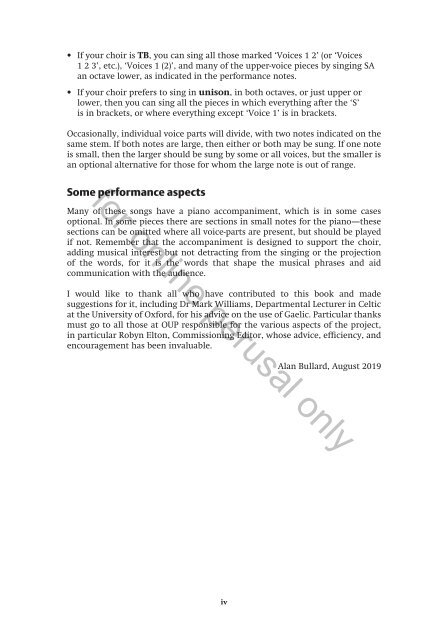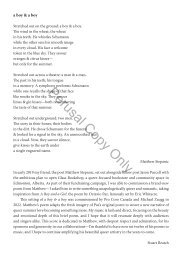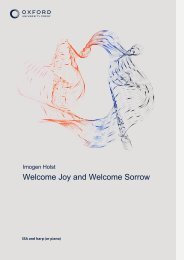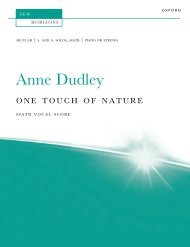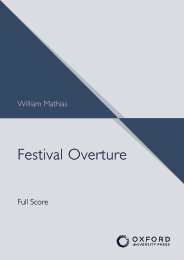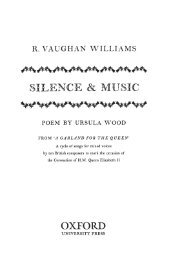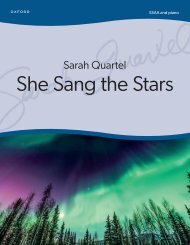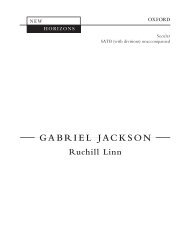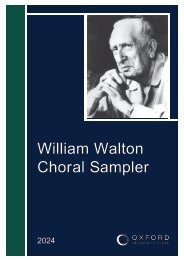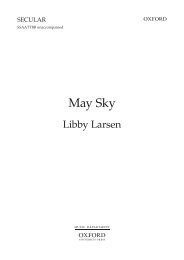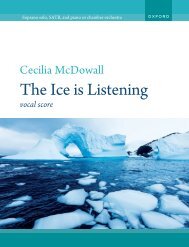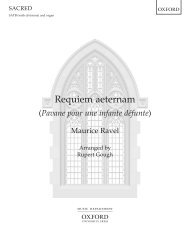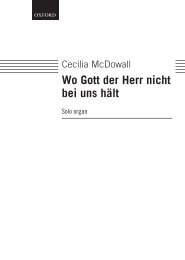- Page 1 and 2: EDITED BY ALAN BULLARD 2 THE OXFORD
- Page 3: 1 Great Clarendon Street, Oxford OX
- Page 7 and 8: TITLE COMPOSER NO. PAGE I should fo
- Page 9 and 10: Listing by Category and Theme Scori
- Page 11 and 12: The Gartan Mother’s Lullaby Trad.
- Page 13 and 14: Notes about the Songs Alan Bullard:
- Page 15 and 16: Almost every choral singer knows Or
- Page 17 and 18: William H. Penn, arr. Alan Bullard:
- Page 19 and 20: for online perusal only
- Page 21 and 22: 2 S A Bar or Unis. Piano in memory
- Page 23 and 24: 4 A flower remembered 17 mp mf & b
- Page 25 and 26: 6 A flower remembered 29 & < ‹ >
- Page 27 and 28: ∏∏∏∏∏∏∏∏∏∏∏
- Page 29 and 30: 10 A Swan 10 ° & # # ?# ¢ # ∑ &
- Page 31 and 32: 12 S A (T) (B) or T B (Percussion)
- Page 33 and 34: S. A. T. B. 14 All will be well { 2
- Page 35 and 36: 16 All will be well 41 ° & bb b b
- Page 37 and 38: 18 All will be well 56 ° & bb b b
- Page 39 and 40: 20 As She Goes S./A. 12 ° & # # #
- Page 41 and 42: 22 As She Goes 34 ° & # # # # ?#
- Page 43 and 44: 24 As She Goes 54 ° 3 & # # # #
- Page 45 and 46: 26 Calm and deep peace / Simple Gif
- Page 47 and 48: 28 Calm and deep peace / Simple Gif
- Page 49 and 50: 30 Calm and deep peace / Simple Gif
- Page 51 and 52: 32 S A (Bar) or T B 7. Canzonet Tho
- Page 53 and 54: 34 Voices 1 2 3 4 8. Celebrate! Wor
- Page 55 and 56:
36 S (A) (T B) or T B (Piano) 9. Ch
- Page 57 and 58:
38 Cherry ripe 21 poco rit. ° & ?
- Page 59 and 60:
40 Cherry ripe ° & ? # œ nnœœ
- Page 61 and 62:
42 Catch a Falling Star S./A. 8 °
- Page 63 and 64:
44 Catch a Falling Star 20 ° & #
- Page 65 and 66:
46 Catch a Falling Star 38 SOPRANO
- Page 67 and 68:
48 Catch a Falling Star 53 ° & # #
- Page 69 and 70:
∏∏∏∏∏ 50 Catch a Falling
- Page 71 and 72:
52 Chimes & bb b { { 10 From mf the
- Page 73 and 74:
54 Chimes S. 29 ° & b œ j œ œ
- Page 75 and 76:
56 Chimes 47 ° & bb b mf Œ. œ œ
- Page 77 and 78:
58 Chimes 69 ° & bb b nœ. œ. œ.
- Page 79 and 80:
60 S (A) (Bar) Piano 12. Dwell on t
- Page 81 and 82:
62 Dwell on the beauty 21 ° & bb b
- Page 83 and 84:
64 Dwell on the beauty 40 ° & bb b
- Page 85 and 86:
66 Eletelephony 1 13 ° & < ‹ > (
- Page 87 and 88:
68 Eletelephony ° & < ‹ > ¢ & <
- Page 89 and 90:
5 A 70 Voices 1 2 Piano for Cantiam
- Page 91 and 92:
72 Fall, leaves, fall 21b ° # & #
- Page 93 and 94:
74 S (A) (T) (B) or T B (Piano) 15.
- Page 95 and 96:
76 Flow my tears 17 ° & & & ‹ ?
- Page 97 and 98:
78 Flow my tears 31 ° & & & ‹ ?
- Page 99 and 100:
80 Flow my tears 46 ° & & œ œ ˙
- Page 101 and 102:
82 The Owl 26 ° & b b < ‹ > ¢ &
- Page 103 and 104:
84 Four Bird Songs Voices 1 2 Anon.
- Page 105 and 106:
86 Four Bird Songs Voices 1 2 John
- Page 107 and 108:
∏∏∏∏∏∏∏∏∏∏∏
- Page 109 and 110:
∏∏∏∏ 90 Greensleeves 22 °
- Page 111 and 112:
92 S A (T) (B) Piano Commissioned b
- Page 113 and 114:
94 If I can stop one heart from bre
- Page 115 and 116:
96 It was a lover and his lass 8 °
- Page 117 and 118:
98 It was a lover and his lass 23
- Page 119 and 120:
100 S A (T) (B) or T B 23. La, la,
- Page 121 and 122:
102 La, la, la 26 ° & bb œ # œ
- Page 123 and 124:
104 Juanita 9 ° & # # ˙ œ œ œ
- Page 125 and 126:
106 Voices 1 (2) 3 (4) Piano 25. My
- Page 127 and 128:
108 My Boy Jack ° # & < ‹ > # ¢
- Page 129 and 130:
110 My Boy Jack 56 ° # & # # < ‹
- Page 131 and 132:
112 My Boy Jack ° & b b œ. < ‹
- Page 133 and 134:
114 S (A) (Bar) (or S A A) Piano fo
- Page 135 and 136:
116 My heart is like a singing bird
- Page 137 and 138:
S. A. 118 My heart is like a singin
- Page 139 and 140:
120 O’er the Waves Let Us Go 16
- Page 141 and 142:
S. A. 122 O’er the Waves Let Us G
- Page 143 and 144:
S. A. 124 O’er the Waves Let Us G
- Page 145 and 146:
126 S (A) (T) (B) or T B (Drum) 28.
- Page 147 and 148:
128 Voices 1 2 3 Piano Commissioned
- Page 149 and 150:
130 Scarborough Fair 30 ° & b <
- Page 151 and 152:
132 Scarborough Fair ° ¢ & b <
- Page 153 and 154:
134 Voices 1 2 3 Piano 30. Spring (
- Page 155 and 156:
136 Spring ° & < ‹ > ¢ & < ‹
- Page 157 and 158:
138 S A (T) (B) or T B Piano 31. St
- Page 159 and 160:
∏∏∏∏∏∏∏∏∏∏∏
- Page 161 and 162:
∏∏∏∏∏∏ 142 Stars of the
- Page 163 and 164:
∏∏∏∏∏∏∏∏∏∏∏
- Page 165 and 166:
146 Sumer is icumen in 9 ° ¢ & <
- Page 167 and 168:
1 2 3 4 148 Sumer is icumen in 33
- Page 169 and 170:
150 Sumer is icumen in ° # & # œ.
- Page 171 and 172:
152 S A (T) (B) or T B (Piano) 33.
- Page 173 and 174:
154 The Darkened Valley 19 ° & & &
- Page 175 and 176:
156 S (A) (T) (B) (Piano) Seosamh M
- Page 177 and 178:
158 The Gartan Mother’s Lullaby 1
- Page 179 and 180:
160 The Gartan Mother’s Lullaby 4
- Page 181 and 182:
162 S (A) (T) (B) or T B (Piano) 35
- Page 183 and 184:
S. A. T. B. 164 The Honeysuckle and
- Page 185 and 186:
166 The Honeysuckle and the Bee 21
- Page 187 and 188:
168 S (A) (T) (B) or T B Piano 36.
- Page 189 and 190:
170 The Tiger f 23 Tempo I ° > > >
- Page 191 and 192:
172 The Tiger 47 ° > > > > > > > >
- Page 193 and 194:
174 The Water Mill 7 ° & bb b ? ¢
- Page 195 and 196:
176 The Water Mill 29 poco tenuto a
- Page 197 and 198:
178 The Water Mill 49 ° & bb b œ.
- Page 199 and 200:
180 The Water Mill 71 ° & bb b œ
- Page 201 and 202:
182 S (A) (Bar) or T B Piano Commis
- Page 203 and 204:
184 The Truth is Great 17 ° ˙. Œ
- Page 205 and 206:
TACET TACET 186 S (A) (Bar) or T B
- Page 207 and 208:
TACET TACET 188 The Way of Peace 9
- Page 209 and 210:
TACET TACET 190 The Way of Peace °
- Page 211 and 212:
192 There alway something sings 7
- Page 213 and 214:
194 There alway something sings 28
- Page 215 and 216:
196 Three Shakespeare Songs S A (Ba
- Page 217 and 218:
198 Full fathom five 31 ° & & ? ¢
- Page 219 and 220:
200 Full fathom five 54 ° & & f mf
- Page 221 and 222:
202 Three Shakespeare Songs S A (Ba
- Page 223 and 224:
204 Hark, hark, the lark 14 ° & #
- Page 225 and 226:
206 Hark, hark, the lark 28 ° & #
- Page 227 and 228:
208 Three Shakespeare Songs S A (Ba
- Page 229 and 230:
210 You spotted snakes 31 ° & # #
- Page 231 and 232:
S. A. BAR. 212 You spotted snakes 7
- Page 233 and 234:
214 You spotted snakes 109 ° & # #
- Page 235 and 236:
216 To Music 8 ° & # mf # ∑ œ.
- Page 237 and 238:
218 To Music 24 ° & # # ˙. œ œ
- Page 239 and 240:
220 Solo(s) S (A) (Bar) (Piano) 45.
- Page 241 and 242:
222 Tom’s gone to Hilo 25 ° CHOR
- Page 243 and 244:
∏∏∏∏∏∏∏∏∏∏∏
- Page 245 and 246:
226 Tread Softly 12 ° ¢ & # # mf
- Page 247 and 248:
S. A. T. 228 Tread Softly 35 ° & #
- Page 249 and 250:
230 Tread Softly 51 ° & # # & # #
- Page 251 and 252:
232 Tread Softly 63 ° & # # Œ pp
- Page 253 and 254:
234 Voices 1 (2) 3 (4) (Percussion)
- Page 255 and 256:
TACET 236 Two Songs of Quisqueya 7
- Page 257 and 258:
TACET 238 Two Songs of Quisqueya 14
- Page 259 and 260:
240 Two Songs of Quisqueya 20 ° #
- Page 261 and 262:
242 Two Songs of Quisqueya 29 ° #
- Page 263 and 264:
244 S (A) (Bar) (Piano) 48. Under t
- Page 265 and 266:
246 Under the greenwood tree rough
- Page 267 and 268:
248 What is the song the stars sing
- Page 269 and 270:
250 What is the song the stars sing
- Page 271 and 272:
252 What is the song the stars sing
- Page 273 and 274:
254 S (A) (T) (B) or T B Piano 50.
- Page 275 and 276:
256 Where did you get that hat? 15
- Page 277 and 278:
258 Why does he gallop? 8 ° & b Al
- Page 279 and 280:
260 Why does he gallop? 24 ° & b
- Page 282:
The Oxford Book of Flexible Choral


